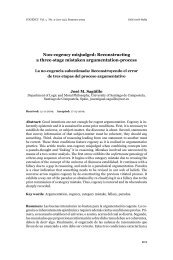Cogency v2 n2
Cogency v2 n2
Cogency v2 n2
You also want an ePaper? Increase the reach of your titles
YUMPU automatically turns print PDFs into web optimized ePapers that Google loves.
COGENCY Vol. 2, N0. 2, Spring 2010<br />
The picture provides us with a richness of simultaneous, alternative interpretations<br />
of which the word can only dream. But this power comes at a<br />
price, and it is that the semantic polyvalence of images makes them unsuitable<br />
instruments for tasks requiring more communicative precision. The<br />
image stands on its own. It argues nothing. It is the user of the image who<br />
argues, using it to make or illustrate or emphasize a particular point. In<br />
order to do so, the power of the image has to be diminished. Its expansiveness<br />
must be closed off and one particular reading privileged over all others,<br />
at least temporarily, so that it may serve the purposes of the arguer.<br />
Because even when it is so restricted the image has power, this is sometimes<br />
acceptable to do in the service of a conclusion that calls for a particularly<br />
powerful presentation.<br />
It is also reasonable to think that artists, at least sometimes, create works<br />
of art for the purpose of use in arguments. This way of reading what Birdsell<br />
and Groarke’s political cartoonist does, what David intended with “The Death<br />
of Marat” and with him Goya and Picasso (and numerous others) in their<br />
politically inspired works does not force us into treating the visual images<br />
as arguments themselves. 15 Even artists who have explicitly political purposes<br />
in mind when they make art, however, must bear in mind that it is not<br />
the artwork that argues. It is the person who deploys the artwork in his or<br />
her argumentation who does so. And the person will always need to use<br />
language in addition to artwork–not because the word is more powerful<br />
than the image, but precisely because the image is more powerful than the<br />
word, and must be reined in if it is to serve the arguer’s purpose.<br />
Wittgenstein himself hints at this in PI, II, iv, when in reference to religious<br />
imagery of the soul he says: And haven’t pictures of these things been<br />
painted? And why should such a picture be only an imperfect rendering of<br />
the spoken doctrine? Why should it not do the same service as the words?<br />
And it is the service which is the point.” Were he to have stopped there, the<br />
thesis of this paper would have been untenable. But he did not stop there,<br />
for a few lines down from this quote, the final paragraph of this section<br />
15<br />
Blair’s (1996) treatment of these examples is particularly good, but does not to my<br />
mind establish that these images are arguments, only that they play, or can play, a supporting<br />
role in a person’s overall campaign of argumentation.<br />
132








